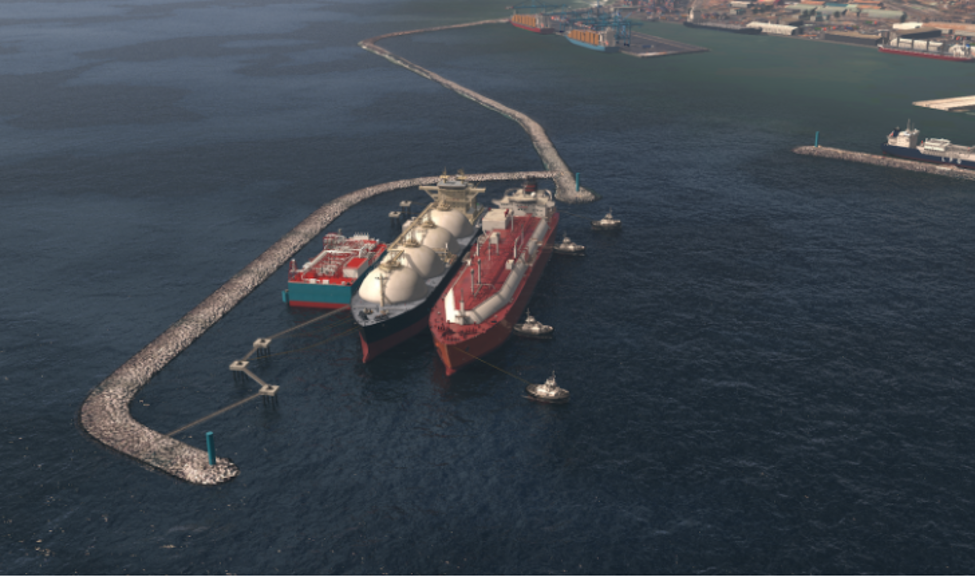In 2018, Tema LNG Terminal Company (TLTC) began construction on Sub-Saharan Africa’s first liquefied natural gas (LNG) import terminal. TLTC will employ an innovative combination of a purpose-built Floating Regasification Unit (FRU) twinned with a modified LNG carrier to receive, store and re-gasify the LNG.
The Tema project will have a capacity of 230 mil. standard cubic feet per day (mmscfd). According to the 2021 Energy Supply Plan, Tema LNG is expected to supply 125 mmscfd in the second half of 2021, bringing Ghana’s total estimated supply to 510 mmscfd. The Supply Plan indicates that total gas demand for 2021 is about 339.5 mmscfd – assuming non-power demand for gas consumes 10% of supply, there will still be a surplus of about 119.5 mmscfd.
Gas will be delivered to the FRU moored permanently off-shore, where it will be re-gasified and sent to the Volta River Authority (VRA) in Kpone across the harbor via a subsea pipeline and then through an existing 6.5km onshore pipeline. TLTC expects first gas by the second half of 2021 according to the Ghana National Petroleum Corporation (GNPC). The GNPC has a supply contract with Royal Dutch Shell and will pay a tolling fee to TLTC.

What are the obstacles?
The Tema LNG project is important for Ghana’s energy security and provides relatively cleaner fuel for power generation and industrial development. But, the project was poorly conceived and faces several uphill battles:
Take-or-pay and oversupply contracting issues. GNPC has not yet secured a sales agreement with any independent power producers (IPPs) or other downstream off-takers to purchase the gas. But once the terminal is commissioned, take-or-pay obligations require that GNPC pays capacity charges, even if there is no buyer. These charges are ultimately passed on to the Ghanian public through taxes and mechanisms such as the energy debt recovery levy. The problem is that Ghana already has more gas contracted than it can offtake, even without this LNG project: in fact, ESRP and the 2019 Integrated Power Sector Master Plan projections indicate that Ghana will not need any more gas contracts for the next five years.
Non-competitive prices. The price of landed LNG is still largely unknown to officials at the Ministry of Energy, IPPs and the Volta River Authority, although there is speculation that it is pegged to the price of Brent crude. The project is primarily aiming to sell to Tema-based industries, but they currently use residual fuel oil (RFO), which is at least 35% cheaper than LNG. The price of supplied LNG will need to come down to push adoption in this market.
Lack of immediate export options. TLTC is considering exporting Ghanaian gas to Côte d’Ivoire. While there is significant gas production potential in Côte d’Ivoire’s Foxtrot field, the Ivoirian Ministry of Energy would favor the development of an LNG facility should gas demand increase – so demand for Ghanaian gas from Côte d’Ivoire is possible, but likely not in the short- to medium-term.
Ghana could also attempt to export via the West African Gas Pipeline (WAGP) to countries such as Benin in the long term. However, WAPCo currently operates a postage stamp rate system which costs more than $3/mmbtu to transport, raising already non-competitive prices. It would also require technical studies and negotiations with both Benin and the pipeline’s owners and the managers.
Lack of distribution infrastructure. The development of a natural gas distribution franchise in Tema to retail gas to industrial users is vital to getting offtake from industries. The Energy Commission is in the process of developing the framework for a gas distribution network, but the development of the concession would take more than a year to complete, and in that time the energy sector is likely to accumulate more debt.
What are the next steps?
Due to the importance of the Tema project to Ghana’s energy security, these challenges must be carefully managed. The government should:
- Unbundle the supply from the terminal user agreement. In this case, GNPC will pay capacity charges for the facility but the LNG will be paid for on a take and pay basis. This will require renegotiation of existing contracts.
- Reduce the quantity of gas to be procured. To prevent oversupply, the amount of gas supplied by Tema LNG should be reduced to less than 100 mmscfd for the first three years of operations. This will provide time to find additional industrial offtakers.
- Extend the distribution network. Developing LNG truck transport and building a market for LNG canisters for cooking and heating would open up additional opportunities for consumption.
- Develop clear and uniform assumptions and methodology for forecasting gas demand. Ghanaian institutions such as the Energy Commission, GPNC, and Ghana Gas have different forecasts of gas demand. A harmonized approach will help:
- Reliably meet local and export demand;
- Avoid over-contracting supply;
- Identify the least-cost combination of existing supply; and
- Meet Ghana’s local environmental and climate change commitments through increasing the share of gas in the energy mix.
- Bring N-Gas (a supplier of gas from Nigeria to Ghana through the WAGP) to the negotiation table to either reduce the take-or-pay quantity or convert the initial contract to take-and-pay. The current contracted value is 123,212 mmscfd with a daily contracted quantity (take or pay) of 75% translating to 92,409 mmscfd. However, N-Gas declared force majeure in 2015 which reduced supply levels and reliability and caused Ghana to seek other sources, indirectly causing the current oversupply issue. Since some of these investments are fixed and long term, reassessing the daily contracted volume can help the country to utilize domestic gas fully, including its already contracted LNG.
